Low blood glucose happens when sugar levels in the blood drop too low for the body to function normally. This condition affects millions of people, especially those with diabetes who take insulin or certain medications.
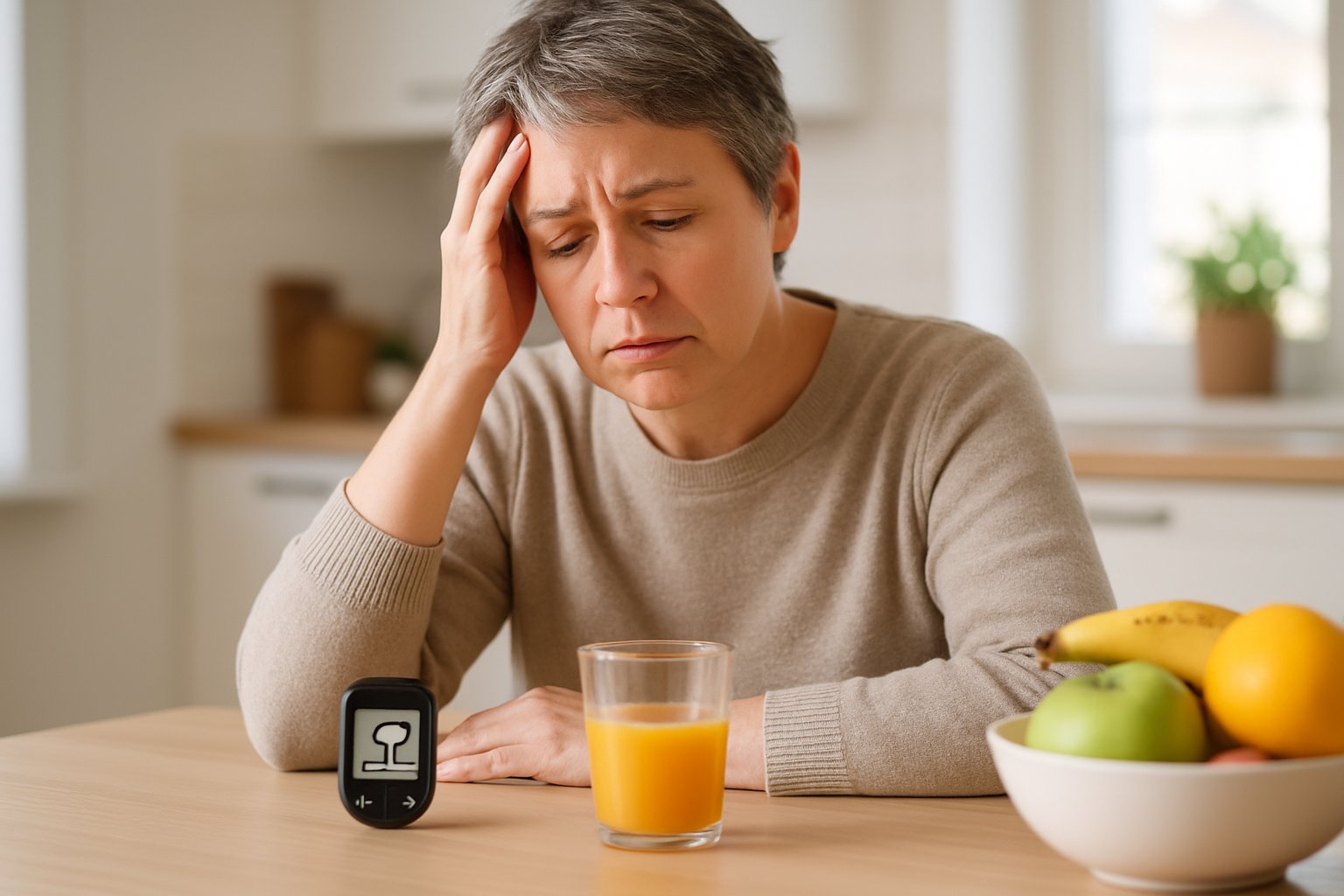
When blood glucose falls below 70 mg/dL, the body cannot get enough energy to work properly, leading to symptoms like shakiness, sweating, confusion, and potentially dangerous complications if left untreated. The brain relies heavily on glucose for fuel, so even small drops can cause noticeable effects.
Understanding what happens during low blood glucose episodes helps people recognize the warning signs early and take quick action. Low blood glucose can quickly become dangerous[1] without proper treatment, making knowledge about this condition essential for anyone at risk.
Key Takeaways
- Blood glucose below 70 mg/dL causes immediate symptoms like shakiness and sweating as the body struggles to function
- The brain is most affected by low blood sugar, leading to confusion, difficulty concentrating, and potentially unconsciousness
- Quick treatment with fast-acting carbohydrates can reverse symptoms and prevent serious complications
Understanding Low Blood Glucose
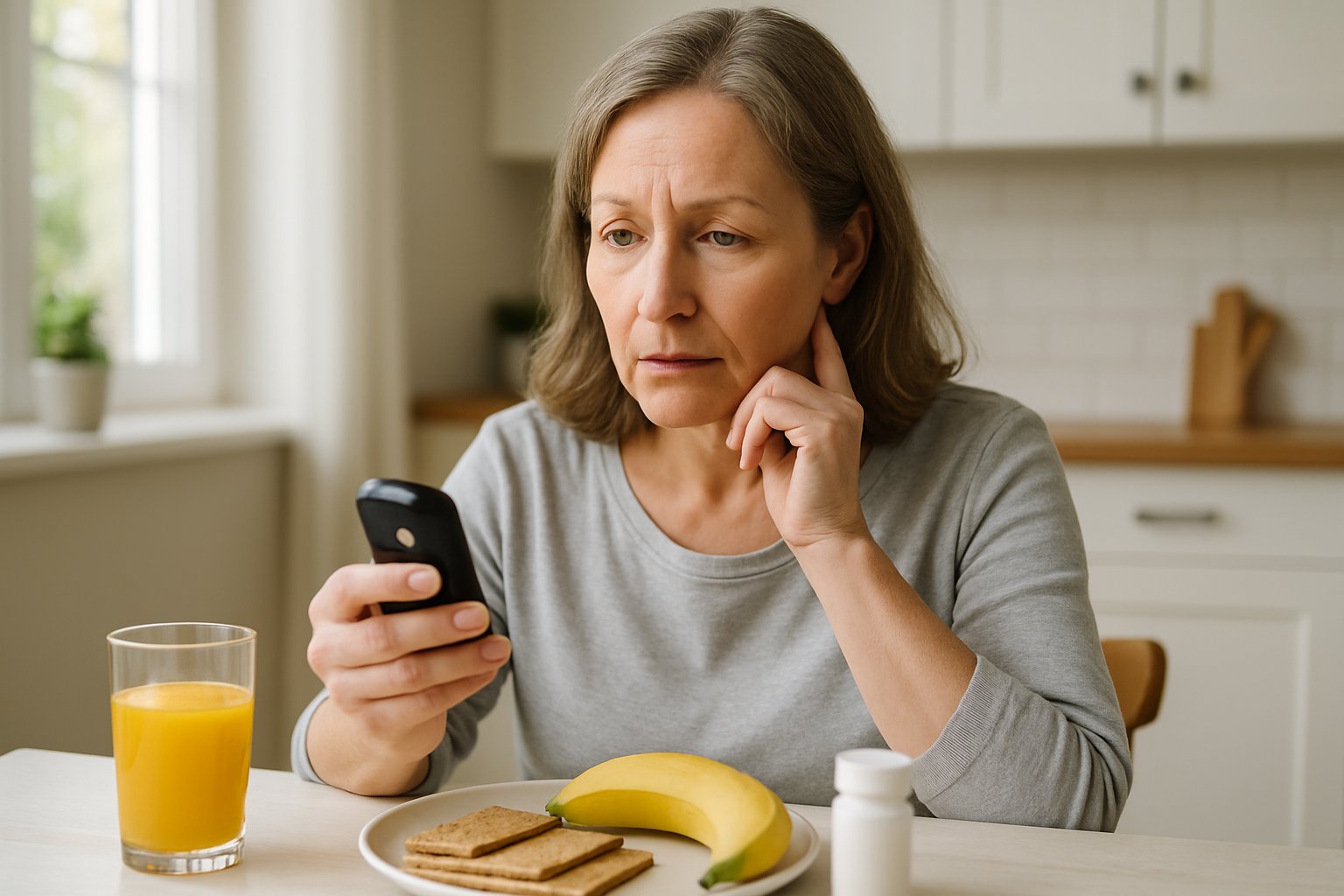
Low blood glucose occurs when sugar levels in the bloodstream drop below normal ranges, typically affecting people with diabetes but also those without the condition. The severity ranges from mild symptoms to life-threatening emergencies requiring immediate medical attention.
What Defines Low Blood Sugar
Blood glucose levels below 70 milligrams per deciliter generally indicate hypoglycemia for most people with diabetes. This threshold serves as the standard medical definition for low blood sugar episodes[2].
However, the exact level varies between individuals. Some people experience symptoms at higher glucose levels, especially those with chronic high blood sugar.
Normal vs. Low Blood Glucose Ranges:
| Blood Sugar Level | Classification |
|---|---|
| 80-130 mg/dL | Normal range |
| 70-79 mg/dL | Borderline low |
| Below 70 mg/dL | Hypoglycemia |
| Below 54 mg/dL | Severe hypoglycemia |
People with consistently elevated blood glucose levels may feel symptoms when their levels drop rapidly, even if still above 70 mg/dL. Their bodies adapt to higher baseline levels as “normal.”
Types and Severity of Hypoglycemia
Hypoglycemia occurs in different forms and severity levels. Mild hypoglycemia causes shakiness, sweating, and hunger but remains manageable with quick treatment.
Mild Hypoglycemia Symptoms:
- Trembling or shaking
- Rapid heartbeat
- Sweating and chills
- Extreme hunger
- Dizziness
Severe hypoglycemia presents dangerous symptoms[2] requiring immediate medical care. These episodes can become life-threatening without prompt treatment.
Severe Hypoglycemia Warning Signs:
- Blurred or double vision
- Slurred speech
- Loss of coordination
- Confusion or disorientation
- Seizures
- Unconsciousness
Nocturnal hypoglycemia happens during sleep. People may experience restless sleep, nightmares, or wake up feeling confused and tired.
Some individuals develop hypoglycemia unawareness, where they stop feeling warning symptoms. This condition increases the risk of severe episodes.
Who Is at Risk for Low Blood Glucose
People with type 1 diabetes face the highest risk for hypoglycemia episodes. They rely on insulin injections and may experience low blood glucose symptoms up to two times per week[3].
Those with type 2 diabetes taking insulin or certain medications also have increased risk. The medications can lower blood glucose levels too much if not properly balanced.
High-Risk Groups:
- People taking insulin
- Those on sulfonylurea medications
- Individuals with irregular eating patterns
- People who drink alcohol frequently
- Those with kidney or liver disease
Non-diabetic individuals can develop hypoglycemia too. Reactive hypoglycemia occurs 2-4 hours after meals, especially those high in simple carbohydrates.
Fasting hypoglycemia affects people without diabetes during prolonged periods without food. Critical illness, excessive alcohol consumption, and certain tumors can trigger these episodes.
Pregnant women with type 1 diabetes experience higher risk during the first trimester due to hormonal changes affecting glucose regulation.
Symptoms and Early Warning Signs
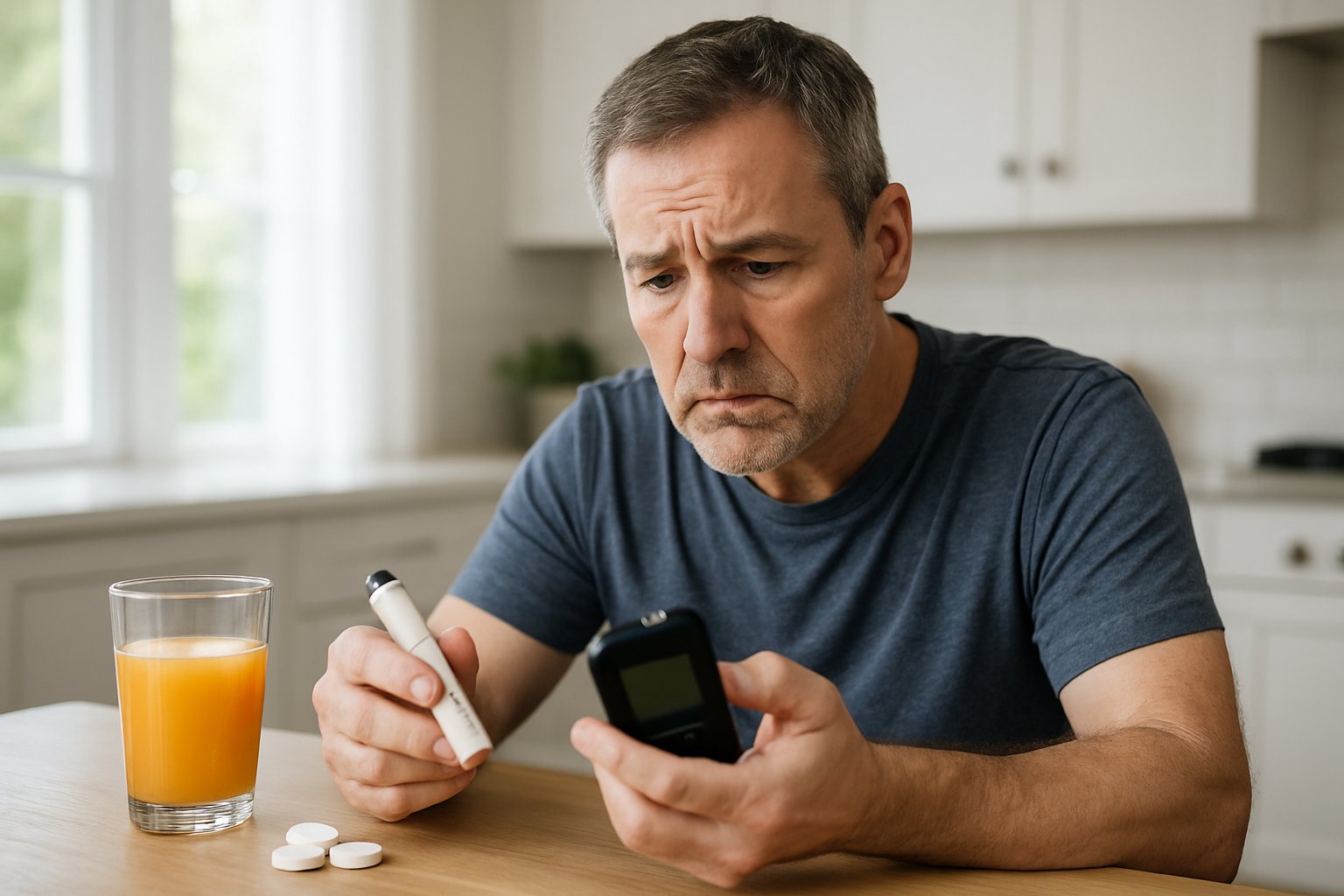
Low blood sugar triggers specific physical and emotional responses that serve as the body’s warning system. These symptoms range from mild discomfort to severe complications that require immediate attention.
Common Symptoms of Low Blood Sugar
The most frequent signs of hypoglycemia include shaking, sweating, and feeling suddenly hungry. These symptoms typically appear when blood glucose drops below 70 mg/dL.
People often experience trembling in their hands first. This shaking happens because the body releases stress hormones to raise blood sugar levels.
Sweating occurs even when the temperature is normal. The skin may feel cold and clammy to the touch.
Other common symptoms include:
- Rapid heartbeat or heart palpitations
- Dizziness or lightheadedness
- Sudden hunger or nausea
- Fatigue or weakness
- Headaches
Recognizing these signs of hypoglycemia[4] helps people take quick action to prevent more serious complications.
Physical and Emotional Indicators
Low blood sugar affects both the body and mind in distinct ways. Physical symptoms often appear first, followed by changes in mood and thinking.
Physical indicators include blurred vision, tingling around the mouth, and coordination problems. Some people notice their speech becomes slurred or unclear.
Emotional changes are equally important to recognize. People may feel irritable, anxious, or confused without understanding why. These mood shifts happen because the brain needs glucose to function properly.
Sleep can also be affected. Nightmares or restless sleep may occur if blood sugar drops during the night.
Children and adults may show different warning signs. Young children might become cranky or refuse to eat, while adults typically notice the physical symptoms first.
Differences Between Mild and Severe Episodes
Mild low blood sugar episodes cause uncomfortable but manageable symptoms. Severe episodes can be dangerous and require emergency treatment.
Mild episodes typically involve shaking, sweating, and feeling anxious or hungry. People can usually treat these symptoms themselves by eating fast-acting carbohydrates.
Moderate episodes may include confusion, difficulty concentrating, and more intense physical symptoms. Speech may become unclear, and coordination problems become noticeable.
Severe episodes can cause seizures, loss of consciousness, or inability to swallow safely. These situations require immediate medical attention or help from others.
The average person with type 1 diabetes experiences symptoms of low blood glucose[3] up to two times per week. Most of these episodes are mild to moderate.
People who experience frequent low blood sugar may lose their ability to recognize early warning signs. This condition makes severe episodes more likely to occur.
Immediate Effects of Low Blood Glucose
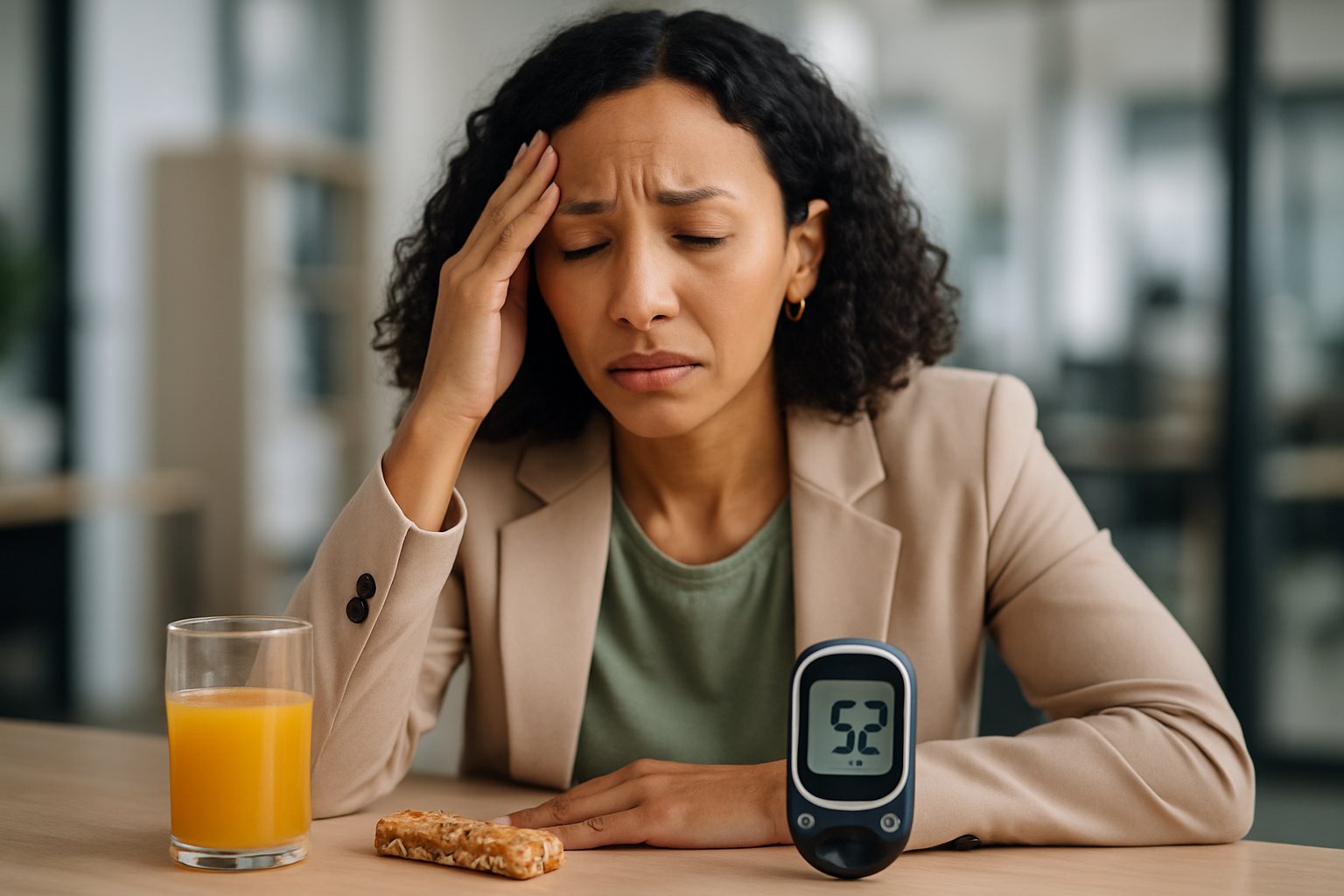
Low blood glucose creates quick changes in both the body and mind. The physical symptoms appear first, followed by problems with thinking and behavior that can become dangerous if not treated.
Short-Term Physical Impacts
The body responds to low blood sugar levels[2] with clear warning signs. These symptoms happen because the brain and muscles need glucose to work properly.
Early Physical Symptoms:
- Sweating and clamminess
- Rapid heartbeat
- Trembling or shaking hands
- Hunger pangs
- Dizziness or lightheadedness
The skin often becomes pale and cool to the touch during hypoglycaemia episodes. Many people experience nausea or feel weak in their legs and arms.
Advanced Physical Signs:
- Blurred or double vision
- Headaches
- Muscle weakness
- Coordination problems
Johns Hopkins reports[3] that people with type 1 diabetes may experience these symptoms up to two times per week. The body releases stress hormones like adrenaline to try to raise blood sugar levels.
These physical changes serve as important warning signals. They tell the person they need to take action quickly before the hypo becomes more serious.
Cognitive and Behavioral Changes
Low blood glucose episodes affect how the brain works because brain cells depend on sugar for energy. Cognitive impairment starts when blood sugar drops below normal levels.
Mental Function Problems:
- Difficulty concentrating
- Confusion or disorientation
- Memory problems
- Slow thinking or response time
- Poor judgment
People often feel anxious, irritable, or moody during low blood sugar episodes. They may become argumentative or act in ways that seem unusual for them.
Behavioral Changes:
- Increased aggression or anger
- Restlessness or nervousness
- Personality changes
- Difficulty speaking clearly
The American Diabetes Association notes[1] that severe low blood glucose can progress to dangerous levels quickly. When the brain doesn’t get enough glucose, more serious symptoms can develop.
Severe Cognitive Effects:
- Extreme confusion
- Inability to complete simple tasks
- Loss of consciousness
- Seizures in extreme cases
These cognitive and behavioral changes make it harder for people to recognize they’re having a hypo. This creates a dangerous cycle where they become less able to treat themselves as symptoms worsen.
Severe and Long-Term Consequences
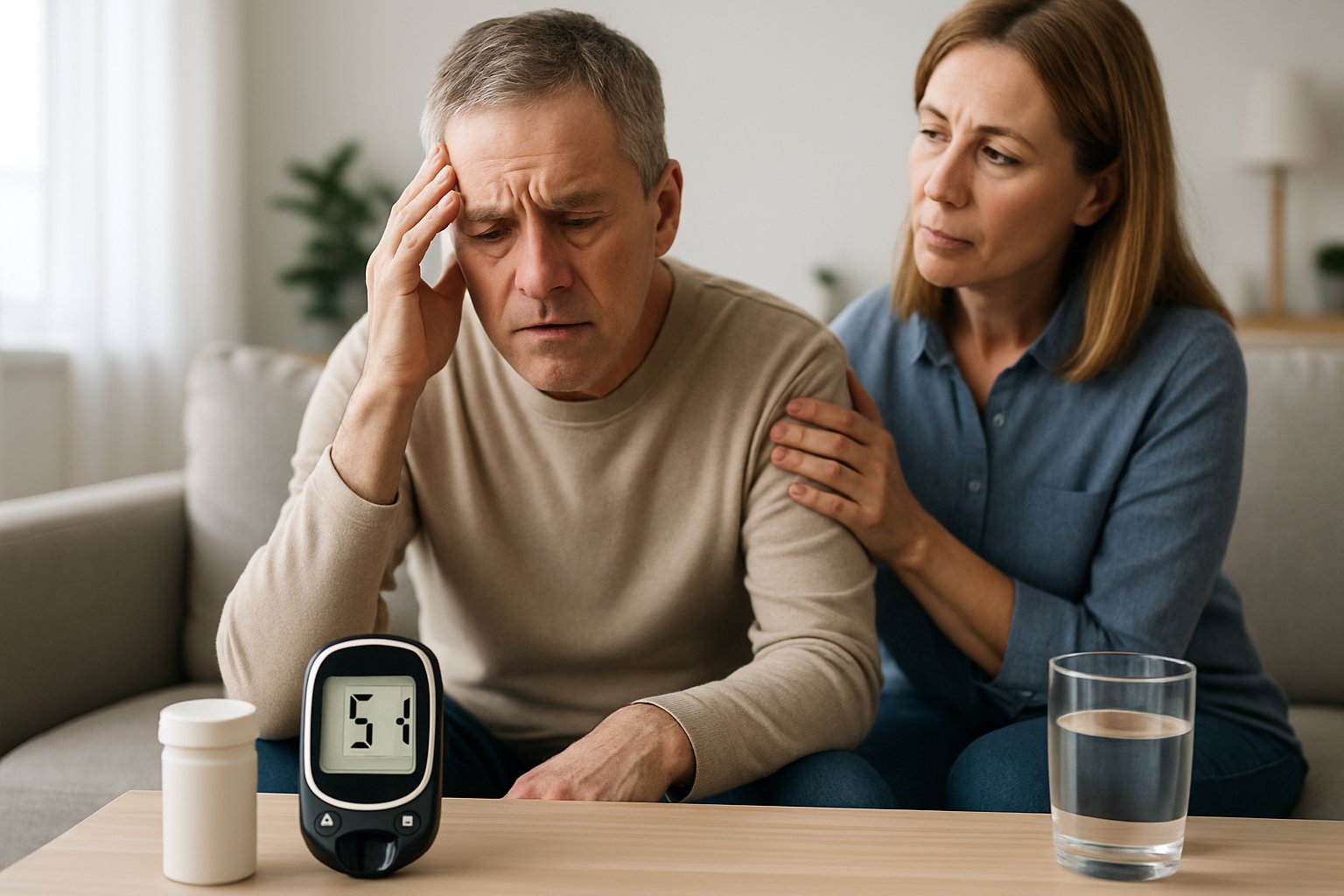
When blood glucose drops to dangerous levels, the body faces serious risks that can become life-threatening. Brain damage, coma, and death are real possibilities if severe episodes go untreated for too long.
Dangers of Untreated Severe Hypoglycemia
Severe hypoglycemia can lead to brain damage, organ damage, or death[5] if left untreated. The brain needs glucose to function properly. When glucose levels stay too low for extended periods, brain cells begin to die.
Immediate life-threatening risks include:
- Seizures that can cause injury
- Loss of consciousness in dangerous situations
- Heart rhythm problems
- Breathing difficulties
Nocturnal hypoglycemia poses special dangers. People may not wake up when their blood sugar drops during sleep. This can lead to prolonged episodes without treatment.
The risk increases significantly for people taking insulin or certain diabetes medications. Those with a history of severe hypoglycemia face higher chances of repeat episodes[5].
Emergency treatment with glucagon becomes critical. Without quick action, what starts as low blood sugar can quickly become a medical emergency requiring hospital care.
Potential for Coma and Brain Damage
Severe low blood sugar can cause a person to fall into a coma within hours. The brain cannot store glucose like other organs can. When blood sugar stays below 40 mg/dL for too long, brain cells start shutting down.
Progressive brain effects include:
- Confusion and altered thinking
- Loss of motor control
- Complete unconsciousness
- Permanent brain injury
Brain damage from hypoglycemia often affects memory and thinking skills first. The hippocampus, which controls memory formation, is especially vulnerable to glucose shortage.
Repeated episodes cause cumulative damage. Each severe episode increases the risk of lasting problems. Children face higher risks because their developing brains need steady glucose levels.
Recovery depends on how long the brain went without adequate glucose. Some people recover completely with quick treatment. Others may have lasting memory problems or difficulty with complex thinking tasks.
The damage can be irreversible once coma occurs. This makes prevention and rapid treatment essential for anyone at risk of severe episodes.
Causes and Risk Factors
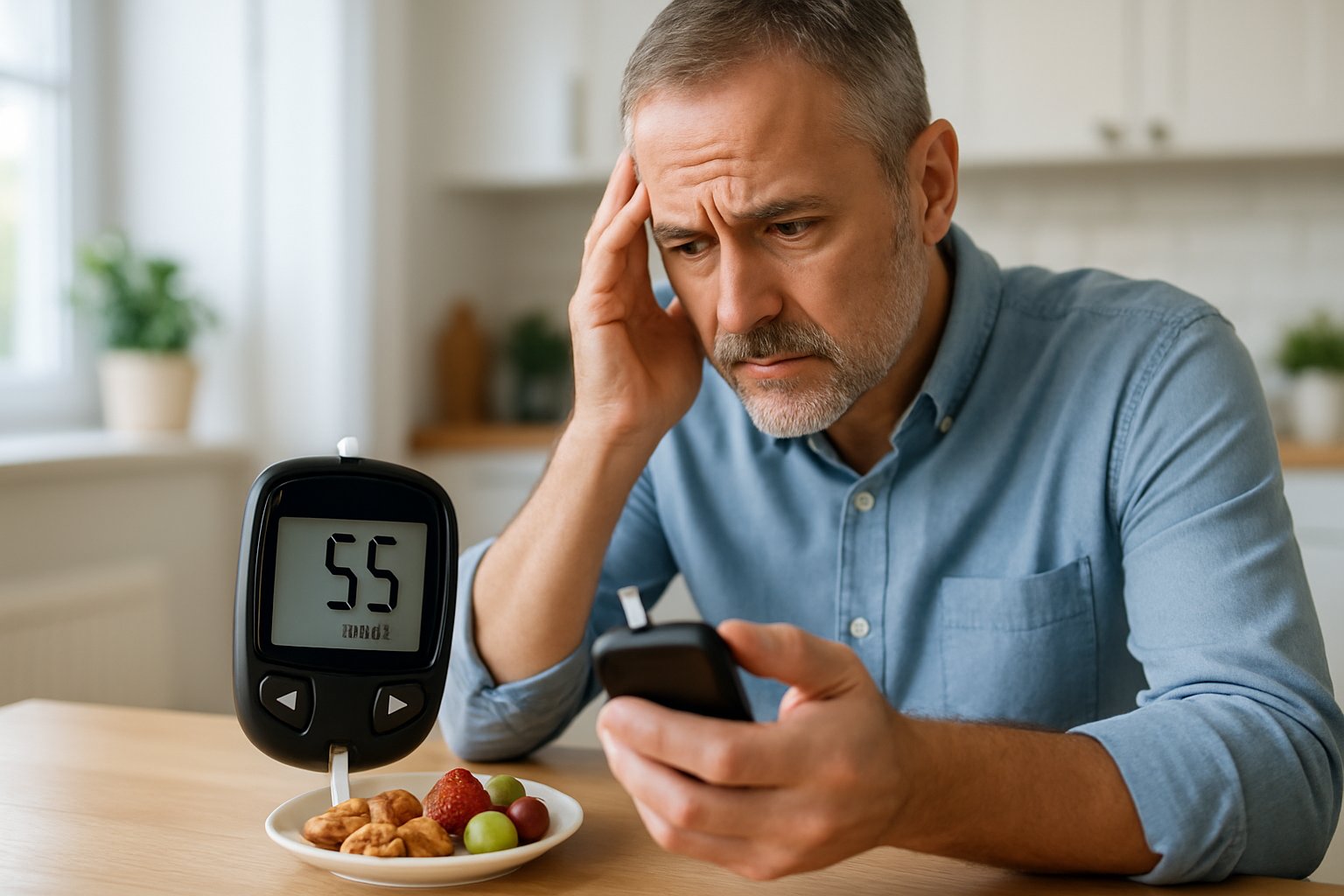
Low blood glucose happens when the body doesn’t have enough sugar for energy. The most common causes include taking too much insulin, skipping meals, exercising without adjusting food intake, and drinking alcohol on an empty stomach.
Medication and Insulin Management
Taking too much insulin is one of the most common causes of low blood glucose[6]. This often happens when people miscalculate how many carbohydrates they ate.
Common insulin mistakes include:
- Forgetting they already took their dose
- Injecting the wrong type of insulin
- Giving insulin but then eating less food than planned
Some diabetes medicines also increase the risk of low blood sugar. These include sulfonylureas and meglitinides, which help the body make more insulin.
Injecting insulin directly into muscle instead of fat can cause blood sugar to drop too fast. People should inject into fatty areas like the stomach, thighs, or upper arms.
Skipping Meals and Fasting
Not eating enough food is a major trigger for low blood glucose. When someone takes insulin or diabetes medicines but doesn’t eat, their blood sugar can drop dangerously low.
High-risk situations include:
- Skipping meals completely
- Eating smaller portions than usual
- Delayed meal times
- Fasting for medical tests
The body needs a steady supply of carbohydrates to maintain normal blood sugar levels. Without enough carbohydrate intake, insulin and diabetes medicines can lower glucose too much.
People who are sick and can’t keep food down face higher risks. They may need glucose tablets or glucose gel to prevent dangerous drops.
Physical Activity and Lifestyle
Physical activity lowers blood glucose by helping muscles use sugar for energy. Exercise can cause low blood sugar during activity or many hours later.
Intense or longer workouts than usual make the body more sensitive to insulin. This effect can last up to 24 hours after exercise.
Exercise-related risk factors:
- Working out without eating enough beforehand
- Not adjusting insulin doses for activity
- Exercising at bedtime without a snack
People may need extra carbohydrates before, during, or after physical activity. The timing depends on the type and length of exercise.
Sleep problems and stress can also affect blood sugar control. Irregular sleep schedules may increase the risk of overnight lows.
Alcohol and Other Triggers
Alcohol can cause dangerously low blood glucose[6], especially on an empty stomach. The liver focuses on processing alcohol instead of making glucose.
Low blood sugar from alcohol can happen many hours after drinking. This makes it particularly dangerous because people may not connect their symptoms to alcohol use.
Other triggers include:
- Hot weather or hot baths
- Hormonal changes during menstruation
- Kidney or liver problems
- Some antibiotics and heart medicines
Certain medical conditions can also increase risk. These include adrenal gland problems, severe infections, and eating disorders.
People taking multiple medicines should check with their doctor about drug interactions that might affect blood glucose levels.
Diagnosis and Monitoring
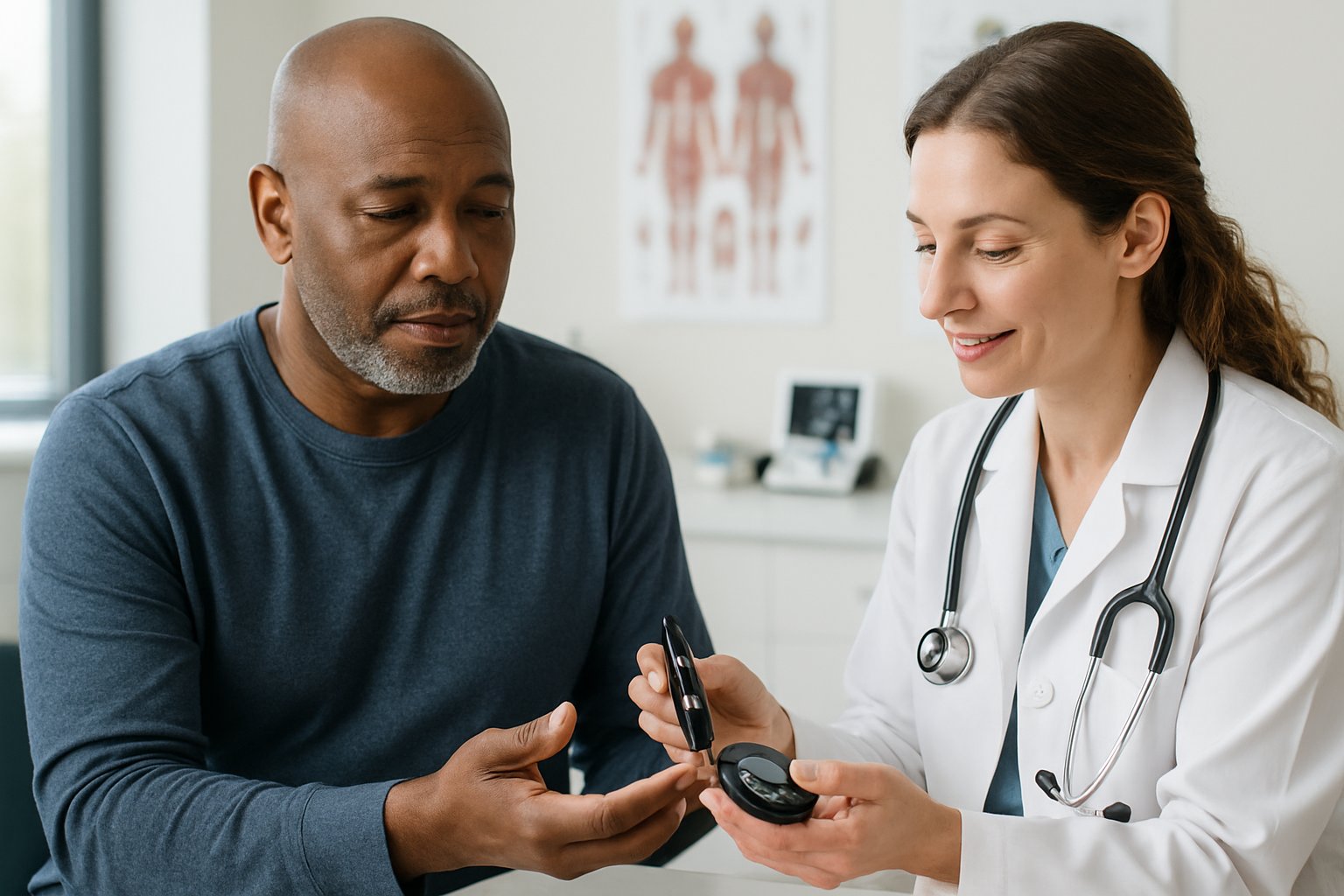
Doctors use several methods to check blood sugar levels and spot low glucose episodes. Modern tools like continuous glucose monitors help track patterns, while some people lose the ability to feel warning signs.
Testing Blood Sugar Levels
A blood glucose meter gives the most accurate reading for diagnosing low blood sugar. Low blood glucose occurs when levels fall below 70 mg/dL[7].
Standard Testing Methods:
- Fingerstick test: Uses a small blood drop on a test strip
- Laboratory blood test: More precise but takes longer
- Random glucose check: Done any time symptoms appear
People with diabetes should test when they feel symptoms like shakiness, sweating, or confusion. The meter shows exact numbers within seconds.
Healthcare providers may order an A1C test to see average blood sugar over three months. This helps identify patterns of low glucose episodes.
Testing should happen before meals, after meals, and at bedtime. More frequent testing helps during illness or medication changes.
Using Continuous Glucose Monitors (CGM)
A CGM tracks blood sugar every few minutes throughout the day and night. It shows trends and alerts users before dangerous drops occur.
Key CGM Benefits:
- Real-time alerts: Warns when levels drop too fast
- Trend arrows: Shows if glucose is rising, falling, or stable
- Historical data: Reveals patterns over days or weeks
- Overnight monitoring: Catches dangerous nighttime lows
The device uses a small sensor under the skin that measures glucose in tissue fluid. Most CGMs need calibration with fingerstick tests once or twice daily.
CGM data helps doctors adjust medications and meal timing. The technology prevents many severe low blood sugar episodes by giving early warnings.
Recognizing Hypoglycemia Unawareness
Some people lose the ability to feel early warning signs of low blood sugar. This condition makes dangerous episodes more likely.
Common Signs of Unawareness:
- No shakiness, sweating, or hunger during lows
- Blood sugar drops below 50 mg/dL without symptoms
- Others notice confusion before the person feels anything
- Frequent severe episodes requiring help from others
Hypoglycemia unawareness develops after repeated low blood sugar episodes. The body stops releasing hormones that create warning symptoms.
CGM becomes essential for people with this condition. The device provides alerts they cannot feel naturally.
Doctors may adjust treatment goals to allow slightly higher blood sugar levels. This helps restore the body’s ability to sense dangerous drops.
How to Treat and Prevent Low Blood Glucose
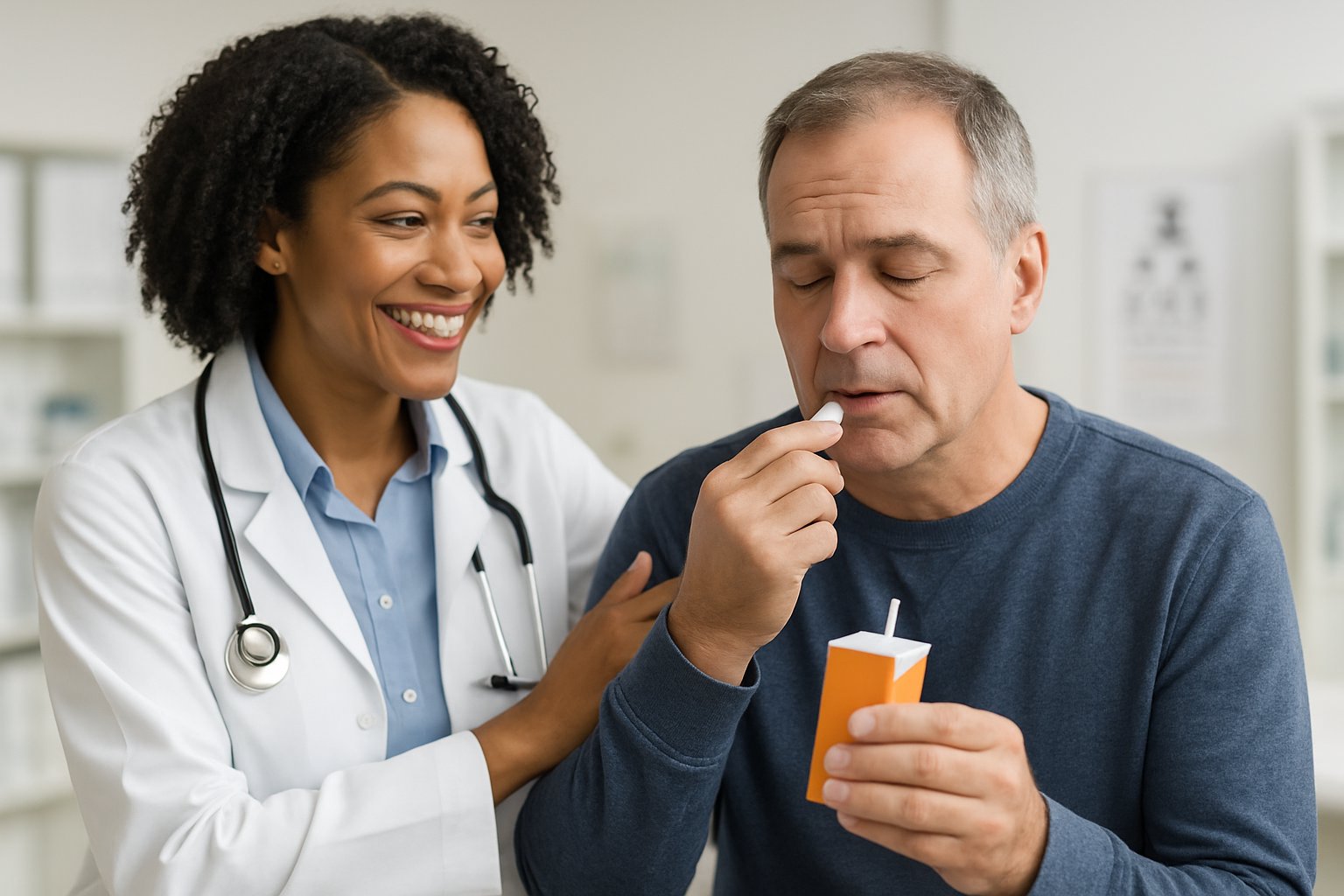
Quick treatment with fast-acting carbohydrates can raise blood sugar within 15 minutes, while glucagon injections help in severe cases. Regular monitoring and meal planning prevent most episodes from occurring.
Immediate Treatment for Low Blood Sugar
The 15-15 rule provides effective treatment[8] for mild low blood sugar episodes. A person should consume 15 grams of fast-acting carbohydrates, wait 15 minutes, then check their glucose level again.
Fast-Acting Treatment Options:
- 4 ounces of fruit juice or regular soda
- 3-4 glucose tablets
- 1 tablespoon of honey or sugar
- 2 tablespoons of raisins
- 6-8 hard candies
Pure glucose works fastest because it enters the bloodstream quickly. Symptoms like shakiness and confusion[9] should improve within 5-15 minutes.
People should avoid overtreating by eating too many carbohydrates. This can cause blood sugar to swing too high.
After glucose levels normalize, eating a small snack with protein helps maintain stable levels. Good options include crackers with peanut butter or a turkey sandwich.
When to Use Glucagon
Glucagon injections treat severe hypoglycemia[8] when someone cannot swallow or loses consciousness. This hormone tells the liver to release stored glucose into the bloodstream.
Two main forms are available: injectable glucagon and nasal powder. Injectable options include Gvoke and Zegalogue, while Baqsimi delivers glucagon through the nose.
Emergency Situations Requiring Glucagon:
- Person is unconscious or unresponsive
- Blood sugar stays below 50 mg/dL despite treatment
- Severe confusion or inability to swallow safely
Family members and caregivers should learn how to use glucagon kits. The medication works within 10-15 minutes of administration.
Emergency medical help is needed[8] if glucagon doesn’t improve symptoms or if the person has seizures.
Prevention Strategies and Lifestyle Adjustments
Regular blood sugar monitoring helps catch drops before symptoms appear. People with diabetes should check glucose levels[10] multiple times daily, especially before meals and exercise.
Consistent meal timing prevents blood sugar dips. Eating every 3-4 hours keeps glucose levels steady throughout the day.
Key Prevention Steps:
- Take diabetes medications exactly as prescribed
- Never skip meals or snacks
- Plan extra carbohydrates before exercise
- Keep glucose tablets or juice nearby
- Wear medical identification jewelry
Exercise requires special planning for diabetes management. People should check their glucose before, during, and after physical activity. Extra carbohydrates may be needed to prevent drops.
Alcohol can lower blood sugar hours after drinking. People should eat food when consuming alcohol and monitor glucose more frequently.
Working with healthcare providers helps create personalized prevention plans. Regular check-ups allow for medication adjustments and better glucose control.
Frequently Asked Questions
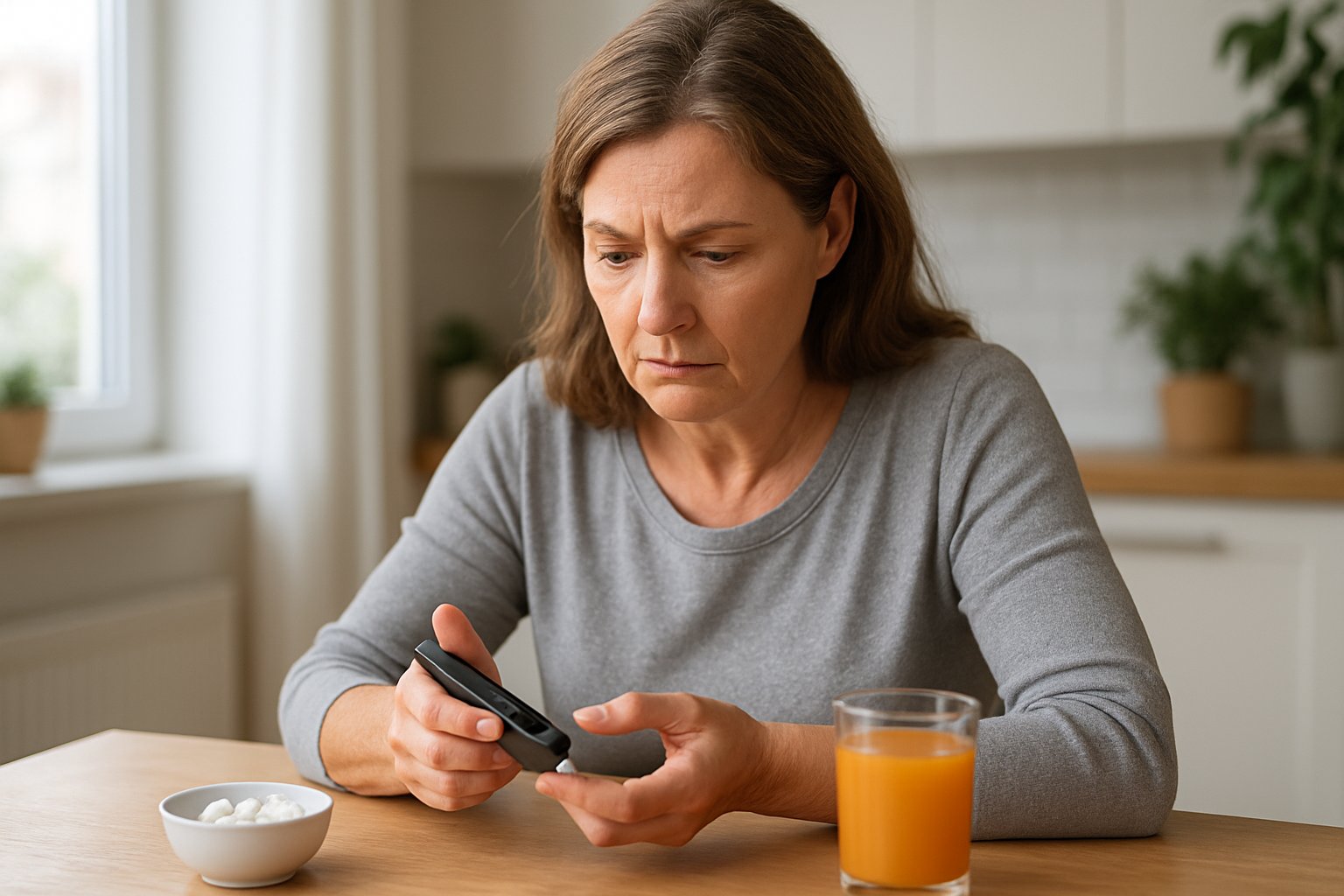
Low blood sugar can occur in people with and without diabetes for different reasons. Understanding the warning signs and proper treatment steps helps prevent dangerous complications.
What are the potential causes of hypoglycemia in individuals without diabetes?
People without diabetes can develop low blood sugar through several different mechanisms. Reactive hypoglycemia occurs two to four hours after eating[2], especially after consuming simple carbs like white bread or pastries.
Excessive alcohol consumption prevents the body from making new glucose cells. When combined with poor eating habits over several days, this can lead to dangerous blood sugar drops.
Critical illnesses like liver disease or kidney failure cause the body to use stored glucose faster than it can create new supplies. Adrenal insufficiency reduces cortisol levels[2], which normally helps raise blood sugar.
Rare tumors called insulinomas produce excess insulin in the pancreas. Some medications like beta-blockers can also trigger low blood sugar episodes.
At what threshold does hypoglycemia become life-threatening?
Blood glucose levels around 70 mg/dL typically trigger symptoms in most people with diabetes. However, the exact threshold varies between individuals based on their usual blood sugar patterns.
Severe hypoglycemia becomes life-threatening[2] when it causes loss of consciousness, seizures, or inability to treat oneself. This medical emergency requires immediate professional treatment.
Prolonged severe episodes can cause permanent brain damage, heart problems, or multiple organ failure. Death becomes possible if treatment is delayed too long.
Which foods are recommended to consume when experiencing hypoglycemia?
Fast-acting carbohydrates work best to quickly raise blood sugar levels. Good options include glucose tablets, fruit juice, regular soda, or hard candies.
About 15 grams of carbohydrates usually helps most adults during mild episodes. This equals roughly half a cup of fruit juice or three to four glucose tablets.
After initial treatment, eating a snack with protein and complex carbs helps stabilize blood sugar longer. Examples include peanut butter crackers or cheese with whole grain bread.
What immediate actions should be taken to manage an episode of low blood sugar?
The first step involves checking blood glucose levels if a meter is available. If not available but symptoms are present, treat immediately rather than wait.
Consume 15 grams of fast-acting carbohydrates right away. Wait 15 minutes, then recheck blood sugar levels to see if they have improved.
If blood sugar remains low, repeat the treatment with another 15 grams of carbs. Call emergency services if the person cannot swallow safely or loses consciousness.
Someone experiencing severe symptoms should not drive or operate machinery until blood sugar normalizes completely.
Can nocturnal hypoglycemia result in fatal outcomes?
Low blood sugar during sleep can be dangerous because the person may not wake up to treat it. Nocturnal hypoglycemia symptoms include restless sleep[2], sweating through sheets, and nightmares.
Severe nighttime episodes can progress to seizures or loss of consciousness without intervention. This creates risk for serious complications including death in extreme cases.
People at high risk should use continuous glucose monitors with alarms. Family members should learn to recognize signs and know emergency treatment steps.
What are common signs and symptoms of hypoglycemia in people who do not have diabetes?
Early warning signs include shaking, sweating, and rapid heartbeat. Many people also experience dizziness, weakness, and extreme hunger during episodes.
Mental symptoms often develop as blood sugar drops further. These include confusion, trouble concentrating, and feeling anxious or irritable.
Severe symptoms include blurred vision, slurred speech, and coordination problems[2]. Loss of consciousness or seizures indicate a medical emergency requiring immediate professional help.
References
- Low Blood Glucose (Hypoglycemia). https://diabetes.org/living-with-diabetes/hypoglycemia-low-blood-glucose Accessed October 23, 2025
- Hypoglycemia (Low Blood Sugar): Symptoms & Treatment. https://my.clevelandclinic.org/health/diseases/11647-hypoglycemia-low-blood-sugar Accessed October 23, 2025
- Hypoglycemia (Low Blood Sugar). https://www.hopkinsmedicine.org/health/conditions-and-diseases/diabetes/hypoglycemia-low-blood-sugar Accessed October 23, 2025
- 9 Warning Signs of Low Blood Sugar. https://www.everydayhealth.com/type-2-diabetes/symptoms/signs-of-low-blood-sugar/ Accessed October 23, 2025
- Severe Hypoglycemia. https://diabetes.org/living-with-diabetes/hypoglycemia-low-blood-glucose/severe Accessed October 23, 2025
- Causes and How to Prevent Hypoglycemia (Low Blood Glucose). https://diabetes.org/living-with-diabetes/hypoglycemia-low-blood-glucose/causes-prevention Accessed October 23, 2025
- Low blood glucose occurs when levels fall below 70 mg/dL. https://www.verywellhealth.com/sugar-crash-5176637 Accessed October 23, 2025
- 15-15 rule provides effective treatment. https://www.verywellhealth.com/hypoglycemia-treatment-1087541 Accessed October 23, 2025
- Attention Required!. https://hopkinsdiabetesinfo.org/hypoglycemia-prevention-and-treatment/ Accessed October 23, 2025
- Access to this page has been denied. https://www.goodrx.com/conditions/hypoglycemia/diabetes-low-blood-sugar-causes-symptoms-prevention-treatment Accessed October 23, 2025
